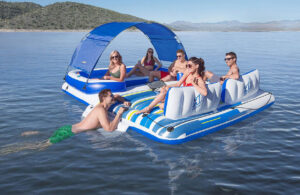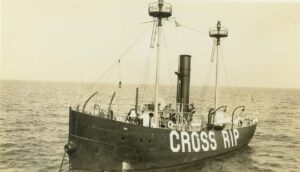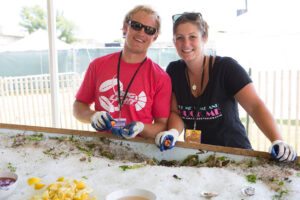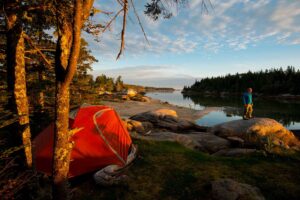Pride of Baltimore II is a replica of a Baltimore Clipper topsail schooner and the only one of its kind in the world. She is 157 feet overall and has a sail area of 9,705 square feet. She represents Maryland and is considered the state’s Goodwill Ambassador. She has sailed nearly 200,000 miles and visited more than 200 ports in 40 countries. Pride II usually has a superb crew of 11 and often hosts a guest crew of six, who works as deck hands with the permanent crew in nearly every aspect of the ship’s operation.
Sailing on a tall ship is an experience most people seldom have the opportunity to do. These grand vessels hold a particular fascination, evoking thoughts of sea battles and pirates, whale hunting, and historic voyages. They reek of adventure, as well as a good bit of mystery and curiosity.

What’s it like to be aboard a tall ship and part of the crew? This is what happens. When boarding, you note that it is kept in pristine condition, evidence of many hours of the crew’s maintenance work. You can only bring what you absolutely need for a voyage. Usually 17 or 18 people, both men and women, live closely together in a living space of 106 feet long and 26 feet wide for extended periods. The permanent crew of 11 lives in the “fo’c’s’le” (forecastle— forward portion of the boat). The six guest crew get small cabins in the middle, and the aft-cabin (the back of the boat) is the captain’s and other officers’ quarters. In such a tight space, privacy rules and considerations are strictly observed.
The crew has very little storage space — either an upper or lower bunk, a couple small shelves, and a hanging hook or two. That’s it. The salon, in the mid-section of the boat, shares space with the guest crew bunks and consists of a long table where the crew eats and relaxes. In a small compact kitchen, food is prepared and stored by the cook. Power is generated by batteries, so great care is taken to conserve electricity. Two toilets are on board, with a small shower and sink in one of them. You must learn how to pump out the toilet and shower day tank. Not doing so … well, you don’t even want to go there. Fresh water is limited, so you must carefully follow a shower procedure. No more 15-minute hot showers, especially on long sea voyages. In the galley, many rules ensure that everyone is safe, well fed and accommodated. Nobody does anything in the galley without the cook’s permission. Daily life on board is an ongoing process of sharing, and for everyone, the learning curve is endless.
The entire crew is divided into “watches.” Each four-hour watch takes on the duties of cleaning, operating and maintaining Pride II. While under sail, there are three watches; in port there are two. During each watch, a group of six oversees the boat. Everyone takes a turn at the helm, checks the readings in the engine room, monitors conditions in the galley and both bathrooms, and stands watch at the boat’s bow. That rotation goes on day and night. The crew follows safety and emergency procedures, general rules of operation like the 144 lines on board, and the proper way to do things.
Adventures are plentiful on a tall ship. I’ve had the great pleasure of sailing on the Pride II on nine occasions. One memorable voyage in 1998 was from Los Angeles to San Diego and then south along the Baja Peninsula to Acapulco. One sunny afternoon while I was on watch, our Second Mate noted a stretch on the fishing line that we drew behind the boat. The call went out, “Fish on!” Soon a 7’5” swordfish was hauled aboard and became delicious crew meal that evening.
On a voyage on October 14, Captain Dan Perrot came on deck, had a good look around and seemed deep in thought. I heard him say, “We have a lurid sky and an oily sea,” but I had no idea what he was talking about. I learned that that description is typical of tropical trouble. A pretty good storm, “Kay” was brewing well to our south.
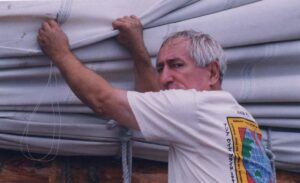
On the night of October 15, we were about 400 nautical miles at sea nearing the cape at the eastern mouth of the Sea of Cortez when weather maps showed a new disturbance in the Gulf of Tehuantepec. We were warned to “Watch out for this one.” About 11:00 p.m. a steady breeze appeared, we put it to good use setting additional sail and made good headway. About midnight, a storm came in with a wallop. The standby watch hit the deck like they were shot from our cannon, and within a few minutes our heading changed to northwest to sail with the wind as the seas and wind steadily increased. I was about to get a memorable lesson from Mother Nature.
Suddenly I had a new understanding of what a true storm at sea was about — being pitched about like a cork, listening to orders and working together. I realized that I didn’t know as much about the sea and sailing as I thought I did, such as how not to get flipped out of a bunk, how to use the bathroom at a 45 degree angle, how to prepare food for hungry shipmates without scraping it off the cabin ceiling and how to hold on.
The rain came like bullets, and we had to be tethered while on deck. To this day, I’m amazed that nobody got sick. I was told that we were just too busy for that nonsense. We spent a lot of time adjusting sails to accommodate the conditions. A wicked sea was running that pulled at our well-ordered world and flung any unsecured item as far as gravity would allow.
A few comic moments lightened the mood. Washed dishes in the galley were air dried as they were placed in the drying rack and then flew out of the rack over our shoulders and onto the cabinets behind us as the boat pitched. It looked like an international game of free-for-all-frisbee. Ah yes, and then there was a visitor — a blue-footed booby who landed on deck during the storm and took up residence. He or she faced into the wind waiting a day or so for the weather to clear. We called him or her Bobbie the Boobie.
Finally, by about 5:30 a.m. on October 16, dawn’s light revealed rips in the foresail and broken mast hoops, which were eventually repaired. Around 7:00 a.m. weather information confirmed that the “loosely organized” disturbance that was 300 nautical miles south had become tropical storm Madeline. She was developing into a hurricane and headed our way. Again, we changed course and made way for safe harbor. As if that weren’t enough, we also heard reports that the depression in the Gulf of Tehuantepec was now to our east and heading west toward us as tropical storm Lester and soon it became Hurricane Lester.
By 1:00 a.m. the wind velocity dropped, and we set sail in a pattern that allowed us to move as close into the wind as possible. That made for slow going but we did make headway and decided to try to reach Puerto Vallarta some 70 nautical miles away before nightfall. Despite the steadily falling breeze, the seas were still large enough that it was well past 9:30 p.m. before we passed through Puerto Vallarta’s breakwaters.
Inside the harbor, all was completely still. The hotel and resort lights illuminated the harbor. A voice called from the darkness, “Welcome to paradise, amigos!” Captain Parrot shouted back, “We’re running from a hurricane.” We were warmly greeted, and the party that next evening to celebrate our survival … well, never in nautical history has there been such a party!
Participating in those voyages taught my wife Bernadette and me much about life. They pushed our emotions and our sense of wonder to the maximum. We are so thankful for having the opportunity to be aboard such a wonderful sailing vessel with warm, skilled and professional captains and crew.
For more info about the Pride of Baltimore II, go to pride2.org


